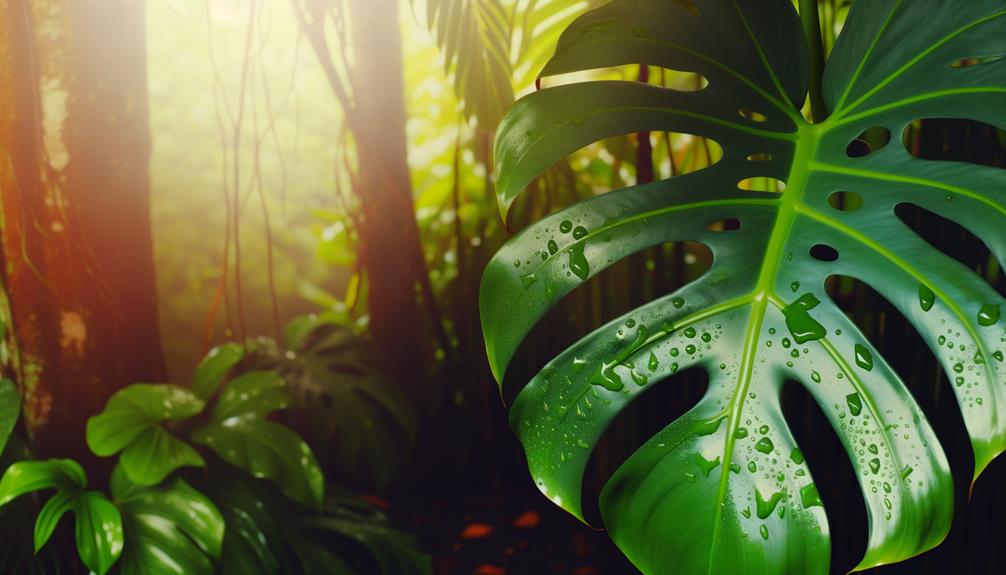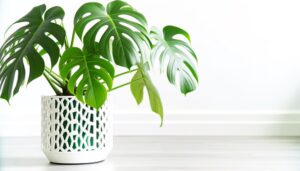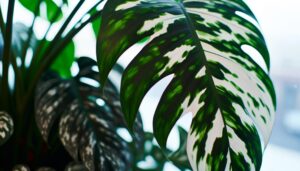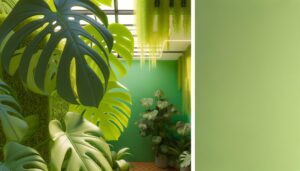Monstera Lechleriana Humidity Needs
Maintaining humidity between 60% and 80% is vital for your Monstera Lechleriana's physiological health and best growth. Ideal humidity supports efficient transpiration and photosynthesis, preventing dehydration and stress.
If humidity drops below 50%, you'll notice stunted growth and browning leaf edges. Use a hygrometer for precise monitoring and mitigate low humidity with humidifiers or misting.
Beware of excess moisture above 80%, which can cause fungal growth. Seasonal adjustments, like winter humidifiers or summer ventilation, help maintain stability.
For more in-depth tips on creating the perfect environment, there's additional information awaiting you.

Key Takeaways
- Maintain humidity levels between 60% and 80% for optimal Monstera Lechleriana growth.
- Use hygrometers to monitor and ensure precise humidity adjustments.
- Signs of low humidity include browning leaf edges and stunted growth.
- Humidifiers, misting, and water trays can help increase indoor humidity.
- Regularly adjust humidity settings seasonally to match environmental changes.
Importance of Humidity
Humidity plays a significant role in the health and growth of Monstera Lechleriana, ensuring ideal physiological functions and preventing stress. It's necessary for processes like transpiration and photosynthesis.
When humidity levels are best, the plant's stomata—tiny openings on the leaf surface—operate efficiently, regulating gas exchange and water vapor loss. Insufficient humidity can cause stomata to close, leading to reduced photosynthetic rates and potential dehydration.
Conversely, high humidity can foster fungal growth, affecting leaf integrity. Studies show that Monstera Lechleriana, native to tropical environments, thrives when humidity mimics its natural habitat.
As a result, monitoring and adjusting home humidity levels can mitigate environmental stressors, promoting robust growth and vibrant foliage. Understanding these mechanisms is essential for maintaining plant vitality.
Ideal Humidity Range
To enhance the health and growth of Monstera Lechleriana, maintaining an ideal humidity range between 60% and 80% is crucial. High humidity levels support peak physiological processes, such as transpiration and nutrient uptake. Research suggests that Monstera Lechleriana thrives in environments resembling its native tropical habitat.
Here's a breakdown of humidity levels and their effects:
| Humidity Level | Effect on Plant | Recommendation |
|---|---|---|
| < 50% | Stunted Growth | Increase humidity |
| 50% – 60% | Suboptimal Growth | Add humidifiers |
| 60% – 70% | Peak Growth | Maintain current level |
| 70% – 80% | Prime Growth | Prime humidity range |
| > 80% | Risk of Fungal Issues | Reduce humidity |
Precisely monitoring humidity levels guarantees your Monstera Lechleriana remains lively and robust.
Signs of Low Humidity
When Monstera lechleriana experiences low humidity, you'll observe specific signs such as browning leaf edges and stunted plant growth. These symptoms result from inadequate moisture, which impairs cellular function and metabolic processes. Addressing humidity levels can mitigate these adverse effects and promote best plant health.
Leaf Edges Browning
Browning edges on Monstera Lechleriana leaves often indicate insufficient moisture levels, requiring immediate attention to prevent further damage. When humidity falls below 60%, the plant's transpiration rate increases, causing leaf tissue desiccation. As a result, the leaf margins turn brown and crispy. Monitoring and adjusting moisture levels is essential for maintaining leaf integrity.
| Humidity Level (%) | Symptom Severity |
|---|---|
| < 50% | Severe browning |
| 50-60% | Moderate browning |
| > 60% | Healthy leaves |
To rectify low humidity, you can employ methods like misting, using a moisture tray, or placing a humidifier nearby. Consistently maintaining optimal moisture levels will help your Monstera Lechleriana remain vibrant and healthy. Regularly check leaf condition to detect early signs of humidity stress.
Stunted Plant Growth
Inadequate moisture levels can hinder the growth of Monstera Lechleriana, leading to stunted development and reduced strength. When humidity drops below ideal levels (60-80%), the plant's physiological processes, such as transpiration and nutrient absorption, become less effective. You may notice smaller leaves, slow growth, and a general lack of energy.
Scientific studies indicate that low humidity stresses the plant, causing it to redirect energy from growth to survival mechanisms. Additionally, the decreased humidity affects stomatal function, limiting carbon dioxide intake and photosynthesis.
To address these issues, consider using a humidifier or placing a water tray near the plant to maintain the necessary moisture levels. Regularly monitor moisture to guarantee your Monstera thrives.
Measuring Humidity Levels
To guarantee your Monstera Lechleriana thrives, maintaining an ideal humidity range of 60-80% is essential.
You can accurately measure humidity levels using hygrometers, which provide real-time readings.
Consistently monitoring these levels allows for precise adjustments, ensuring your plant's environment remains optimum.
Optimal Humidity Range
Accurately measuring the humidity levels around your Monstera Lechleriana is important for ensuring its best growth. This tropical plant thrives in environments where the relative humidity ranges from 60% to 80%.
Research shows that maintaining humidity within this prime range helps prevent leaf browning and promotes vigorous growth. High humidity levels facilitate efficient stomatal function, enhancing photosynthesis and transpiration processes.
Conversely, humidity below 60% can lead to reduced physiological activity and increased susceptibility to pests. Monitoring these levels will help you maintain an environment that mimics the plant's natural habitat.
Tools for Measurement
Several dependable tools can help you measure and maintain the finest humidity levels for your Monstera Lechleriana. Accurate readings are crucial for top-notch growth and health. Consider incorporating the following instruments into your plant care routine:
- Digital Hygrometers: These devices provide precise humidity readings and often include temperature displays.
- Analog Hygrometers: Though less precise than digital options, they offer a quick visual reference.
- Humidistats: These control devices regulate humidity by activating humidifiers or dehumidifiers based on set thresholds.
- Thermo-Hygrometers: Combining temperature and humidity measurements, these are ideal for thorough environmental monitoring.
- Wireless Sensors: These smart devices sync with your smartphone, providing real-time data and alerts.
Using these tools guarantees your Monstera Lechleriana thrives in its ideal humidity range.
Increasing Humidity Indoors
One effective method to increase indoor humidity for your Monstera Lechleriana involves using a humidifier to maintain ideal moisture levels.
You can also group plants together, creating a micro-environment where transpiration raises local humidity.
Place water trays near plants; evaporation from these trays will increase atmospheric moisture.
Another method is misting leaves, although this provides only a short-term humidity boost.
Make sure your plant isn't near heat sources or air vents, as these can dry the air.
For a more permanent solution, consider integrating a humidity monitoring system to continuously assess and adjust indoor levels.
Research indicates maintaining humidity between 60-80% significantly enhances Monstera Lechleriana's growth and foliar health.
Using Humidifiers
To effectively use a humidifier for your Monstera Lechleriana, position it nearby to make certain the plant receives consistent moisture levels, ideally maintaining a range of 60-80% humidity. Consistent humidity promotes ideal physiological processes such as transpiration and nutrient uptake.
Here's how to maximize the efficacy of your humidifier:
- Select a cool mist humidifier for energy efficiency and to prevent leaf burns.
- Monitor humidity levels with a hygrometer to make certain the desired range is maintained.
- Clean the humidifier regularly to prevent mold and bacterial growth, which can harm the plant.
- Use distilled water to reduce mineral deposits that can clog the humidifier.
- Run the humidifier during the day when the plant's stomata are most active.
These steps guarantee your Monstera thrives.
Grouping Plants Together
When you group your Monstera Lechleriana with other plants, it creates a microenvironment that naturally enhances humidity levels around the foliage. This phenomenon, known as mutual transpiration, occurs as plants release water vapor through stomata, increasing localized humidity. By clustering plants, you leverage this natural process to maintain higher ambient humidity, essential for the Monstera Lechleriana's best growth.
| Benefit | Explanation |
|---|---|
| Enhanced Humidity | Increased local vapor from transpiration |
| Disease Resistance | Stable humidity reduces stress on plants |
| Growth Optimization | Consistent moisture levels promote vigor |
Incorporating this method can mitigate the need for mechanical humidifiers, providing a sustainable and low-maintenance solution. Grouping plants also fosters a microclimate that benefits all species involved, creating a synergistic environment.
Seasonal Humidity Adjustments
Understanding the Monstera Lechleriana's humidity needs throughout different seasons is crucial for promoting its optimal growth and health. During winter, indoor heating systems can significantly decrease humidity levels, requiring adjustments.
Boost humidity using a humidifier or pebble tray. In summer, naturally higher humidity may lessen the need for humidifiers. Ensure proper ventilation to prevent excess moisture buildup.
To optimize conditions year-round, consider the following adjustments:
- Winter: Boost humidity using a humidifier or pebble tray.
- Spring: Monitor fluctuations and adjust humidifier settings as needed.
- Summer: Ensure proper ventilation to prevent excess moisture buildup.
- Autumn: Gradually shift from summer to winter humidity levels.
- Year-Round: Regularly check humidity levels with a hygrometer.
Conclusion
Ironically, your Monstera lechleriana's health hinges on something as simple as humidity. When you maintain an ideal range of 60-80%, it thrives, avoiding the stress of low humidity. You'll notice its leaves unfurling beautifully, a sign you've nailed it.
Regularly measure levels and use humidifiers, grouping plants for mutual benefit. Seasonally adjust to keep conditions stable.
Coincidentally, your plant's vibrant growth mirrors your commitment to understanding its needs, proving that humidity is more than just moisture—it's life.






